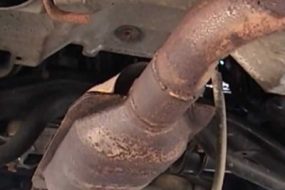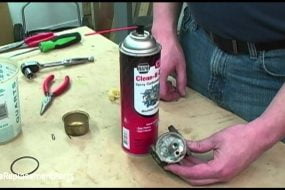
An electronic device measuring the rate of oxygen in a liquid or gas being under observation, analysis, or use is called an oxygen sensor.
An oxygen sensor is rated one of the most essential sensors in a car. Residing in the exhaust manifold of your car, it detects components of your exhaust with the inclusion of oxygen that helps supervise your car and its output.
The readings of your oxygen sensors transit to your engine in solid time, and helps in the determination of your car’s fuel-to-air ratio. So, if your o2 sensor goes bad, what to do after replacing oxygen sensor?
The best thing to do after replacing an oxygen sensor is to reprogram or reset your car’s computer to enable the ECU receive updated information from the newly installed 02 Sensor(s). You can do this either by using a scan tool to do the reset or by driving the car for a few miles.
Can I Replace my Oxygen Sensor?
Yes. You can replace your Oxygen Sensor. Oxygen sensors do not have complexities surrounding their replacement. One who is not so experienced with cars can replace an Oxygen Sensor.
The cost of Oxygen Sensors comparatively is not backbreaking and a regular change can help avert more costly faults that may potentially ground your vehicle.
Once an Oxygen Sensor goes bad, replacing it is effective in the improvement of your fuel economy at about 40percent, says research.
What to Do After Replacing Oxygen Sensor
After replacing your oxygen sensor, you need to scan and reprogram or reset your computer to enable the ECU to receive updated information from the new 02 Sensor(s).
The total cost of replacing your bad Oxygen Sensor varies hugely, depending on the model you drive.
However, if you have managed to bear the cost of replacement, you must reset your computer to enable the ECU to receive updated information from the new 02 Sensor(s).
Otherwise known as the Electronic Control Unit or the Engine Control Unit, the ECU adjusts your air-to-fuel ratio to boost your fuel combustion.
Upon the replacement of your Sensor, please reset your ECU. By resetting, you help it access information from your newly fixed O2 sensor.
How Many Miles Do I Have to Drive After Replacing Oxygen Sensor?
How many miles to drive after replacing the oxygen sensor depends on your type of car. For most vehicles, you must drive for only about 10 minutes (which at a speed of 30 mph is around 5 miles) for your oxygen sensors to reset.
However, for some other cars, you may need to cover up to about 50 miles to secure sensor reset. Importantly, know your car. Yes! Know your vehicle and its littlest peculiarity. This way, you know what fits and can handle it better!
When Should I Replace my Oxygen Sensor?
While the recommendation for replacement is at every 60,000 to 90,000 miles, signs that inform you of the need for replacement are:
1. An Aging Vehicle
Combustion consequences like oil ash, lead or fuel additives can lace the Oxygen Sensors. On the occurrence of this, your sensors become incapable of sending signals to your engine’s computer.
Nothing causes your Oxygen Sensors to fail faster than the use of inappropriate non-recommended or low-quality gasoline.
You should consider this recommendation for the goodness of your car: where your car is less than 15 years old, contact a professional to replace your oxygen sensors every 60,000 to 90,000 miles.
This reduces pollution and does your engine the advantage of smooth running. In the case of your older vehicle, every 45,000 to 65,000 miles is okay to replace your Oxygen Sensors
2. Faulty Gas Mileage
A high rate of fuel consumption which causes you to spend more than regular on fuel may be traceable to a bad Oxygen Sensor.
Fewer efficiency sets in for engines when the oxygen to fuel ratio is discovered to be too rich or too lean. As it is usual for Oxygen Sensors to grow less effective with time, it is easier for you to detect the rate of gas mileage.
3. A Rough Idle
The impact of bad Oxygen Sensors on the combustion intervals of your engine, it’s timing, and other quintessential operations could make you notice stalling or outright slow acceleration. It can cause rough idle which can be uncomfortable especially when you have people in your car.
4. Emissions Test Failure
The cause of the majority of emissions test failure is linked with a faulty Oxygen Sensor.
Thousands of dollars may be the price you would pay to get your vehicle in a good working state again if a poor sensor is not replaced as early as possible.
Apart from the stress of a smell as foul as that of a decomposing egg, the risk of exposure to carbon monoxide is high.
5. Gleaming Check Engine Light
With a bad Oxygen Sensor, your bright orange check engine light will noticeably gleam as you stare in the dashboard.
However, you must contract professional hands to observe your vehicle and detect its fault from time to time. You should not ascribe a fault to your car by mere assumption.
For instance, a loose gas cap or another issue with the engine could be responsible for the same check engine light.
Final Thoughts
No vehicle deserves any bad part. Deeply more, no vehicle deserves to be used ignoring any of its bad parts. No. Not with the height of service vehicles render.
Not with the comfort of relief vehicles afford. You must not ignore particularly sensitive parts. Frankly, whatever part of your car which can impede its movement if bad deserves the most attention.
Oxygen Sensors are not so expensive. With less than $100 in some cars and $300 in some others, your car is in topmost health and ready to hit the highway on new Sensors. Why hesitate to fix your little pet on wheels?









